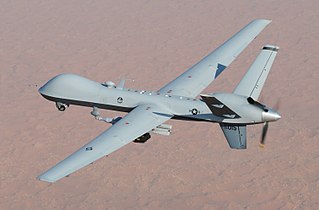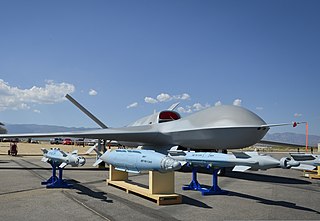Related Research Articles

The AAI RQ-7 Shadow is an American unmanned aerial vehicle (UAV) used by the United States Army, Australian Army, Swedish Army, Turkish Air Force and Italian Army for reconnaissance, surveillance, target acquisition and battle damage assessment. Launched from a trailer-mounted pneumatic catapult, it is recovered with the aid of arresting gear similar to jets on an aircraft carrier. Its gimbal-mounted, digitally stabilized, liquid nitrogen-cooled electro-optical/infrared (EO/IR) camera relays video in real time via a C-band line-of-sight data link to the ground control station (GCS).

An unmanned aerial vehicle (UAV), commonly known as a drone, is an aircraft without any human pilot, crew or passengers on board. UAVs are a component of an unmanned aircraft system (UAS), which include additionally a ground-based controller and a system of communications with the UAV. The flight of UAVs may operate under remote control by a human operator, as remotely-piloted aircraft (RPA), or with various degrees of autonomy, such as autopilot assistance, up to fully autonomous aircraft that have no provision for human intervention.

An unmanned combat aerial vehicle (UCAV), also known as a combat drone, colloquially shortened as drone or battlefield UAV, is an unmanned aerial vehicle (UAV) that is used for intelligence, surveillance, target acquisition, and reconnaissance and carries aircraft ordnance such as missiles, ATGMs, and/or bombs in hardpoints for drone strikes. These drones are usually under real-time human control, with varying levels of autonomy. Unlike unmanned surveillance and reconnaissance aerial vehicles, UCAVs are used for both drone strikes and battlefield intelligence.

The Boeing Insitu ScanEagle is a small, long-endurance, low-altitude unmanned aerial vehicle (UAV) built by Insitu, a subsidiary of Boeing, and is used for reconnaissance. The ScanEagle was designed by Insitu based on the Insitu SeaScan, a commercial UAV that was intended for fish-spotting. The ScanEagle continues to receive improvements through upgrades and changes.

The General Atomics MQ-9 Reaper is an unmanned aerial vehicle (UAV) capable of remotely controlled or autonomous flight operations developed by General Atomics Aeronautical Systems (GA-ASI) primarily for the United States Air Force (USAF). The MQ-9 and other UAVs are referred to as Remotely Piloted Vehicles/Aircraft (RPV/RPA) by the USAF to indicate their human ground controllers.

The HESA Ababil is an Iranian single-engine multirole tactical unmanned aerial vehicle manufactured by Iran Aircraft Manufacturing Industrial Company (HESA). The Ababil comes in two main lines, the Ababil-2 and the Ababil-3, of which the former has a number of variants. It is considered a long-range, low-technology drone.

The Qods Mohajer is an Iranian single-engine tactical unmanned aerial vehicle (UAV) built by the Qods Aviation Industry Company in four main variants from the 1980s to the present day. The Mohajer family is primarily used for reconnaissance, and is among the most mature and well-known Iranian UAVs.

The General Atomics MQ-20 Avenger is a developmental unmanned combat air vehicle built by General Atomics Aeronautical Systems for the U.S. military.

The Lockheed Martin RQ-170 Sentinel is an American unmanned aerial vehicle (UAV) developed by Lockheed Martin and operated by the United States Air Force (USAF) for the Central Intelligence Agency (CIA). While the USAF has released few details on the UAV's design or capabilities, defense analysts believe that it is a stealth aircraft fitted with aerial reconnaissance equipment. Introduced in 2007, it has been deployed to Afghanistan in late 2007, and to South Korea two years later, in September 2009. Some images and details of the aircraft were released after Iran captured an RQ-170 in 2011. It has a flying wing design, and uses a single engine, speculated to be either a General Electric TF34 turbofan or a Garrett TFE731.

The HESA Karrar is an Iranian jet-powered target drone manufactured by Iran Aircraft Manufacturing Industrial Company (HESA) since 2010. The Karrar is a derivative of the American 1970s-era Beechcraft MQM-107 Streaker target drone, probably incorporating elements from the South African Skua, with hardpoints added for munitions. But the reality is that this UAV is based on a domestic design without any foreign company. The Karrar was developed during the Ahmadinejad presidency.

The Shahed 129 is an Iranian single-engine medium-altitude long-endurance unmanned combat aerial vehicle (UCAV) designed by Shahed Aviation Industries for the Islamic Revolutionary Guard Corps (IRGC). The Shahed 129 is capable of combat and reconnaissance missions and has an endurance of 24 hours; it is similar in size, shape and role to the American MQ-1 Predator and is widely considered the most capable drone in Iranian service.

Raad or Ra'd is an Iranian modern aerial defence system deployed in September 2012.The system is designed to enhance Iran's capabilities in terms of defense, and as a partner to Bavar 373 air defense system. According to Fars news agency the Raad is designed to confront fighter jets, cruise missiles, smart bombs, helicopters and drones. The system is also designed specially for US fighters. The system is equipped with "Taer" (Bird) missiles, which can trace and hit targets in ranges up to 105 km and in altitudes from 25 to 27 km, Ra'd is a mid-range radar system and air defense system.

The Qods Yasir, also known as the Sayed-2, is an Iranian light tactical surveillance and reconnaissance unmanned aerial vehicle (UAV) manufactured by Qods Aviation. It is ostensibly an unlicensed copy of an American Boeing Insitu ScanEagle drone captured and reverse-engineered by Iran, but has some design changes.

The Krasukha is a Russian mobile, ground-based, electronic warfare (EW) system. This system is produced by the KRET corporation on different wheeled platforms. The Krasukha's primary targets are airborne radio-electronics and airborne systems guided by radar. The Krasukha has multiple applications in the Russian Armed Forces.
A loitering munition is a weapon system category in which the munition loiters around the target area for some time, searches for targets, and attacks once a target is located. Loitering munitions enable faster reaction times against concealed or hidden targets that emerge for short periods without placing high-value platforms close to the target area, and also allow more selective targeting as the actual attack mission can be aborted.

The Sadid-1 is an Iranian TV-guided anti-tank missile derived from Iran's Toophan missiles.

The Qods Mohajer-6 is an ISTAR UAV capable of carrying a multispectral surveillance payload and/or up to two precision-guided munitions. Ten have been manufactured as of February 2018 for the IRGC Ground Forces, and 40 are planned for the IRGC Navy. The Mohajer-6 complements the larger Shahed 129 operated by the third IRGC branch, the IRGC-ASF. Three have also been delivered to the Iranian Army.
In the mid-1980s, Iran became interested in unmanned aerial vehicles (UAVs). Iranians have since began manufacturing (UAVs). As an attack munition rather than intelligence, surveillance, or reconnaissance (ISR) platform, the first generation Ababil appears to have been deployed during the Iran-Iraq war.
References
- ↑ "The Arkenstone - ارکنستون: Mohajer UAV". 5 March 2015.
- ↑ Wright, Galen (5 March 2015). The Arkenstone - ارکنستون: Mohajer UAV.
- ↑ "The Aviationist » Ra'ad 85" . Retrieved 13 November 2014.
- ↑ "Iran builds new indigenous UAV dubbed Ra'ad 85" . Retrieved 13 November 2014.
- ↑ "Iran's army develops new suicide drone". 28 September 2013. Retrieved 13 November 2014.
- ↑ Ahmad, Naveed (2 June 2019). "The Advent of Drones: Iran's Weapon of Choice" (PDF). International Institute for Iranian Studies (Rasanah).[ dead link ]
- ↑ ايران, عصر. پرونده ای برای هواپیماهای بدون سرنشین ایران. عصر ايران (in Persian). Asr-e Iran.